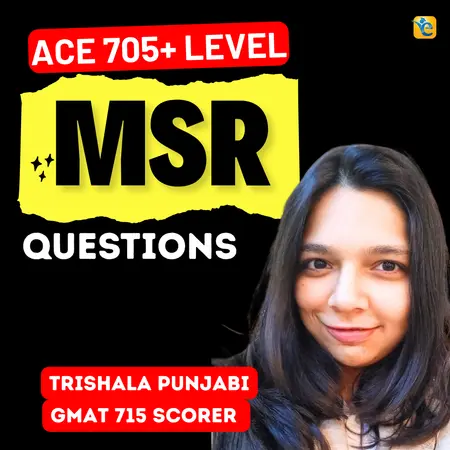Events & Promotions
|
|

GMAT Club Daily Prep
Thank you for using the timer - this advanced tool can estimate your performance and suggest more practice questions. We have subscribed you to Daily Prep Questions via email.
Customized
for You
Track
Your Progress
Practice
Pays
Not interested in getting valuable practice questions and articles delivered to your email? No problem, unsubscribe here.
- Nov 22
11:00 AM IST
-01:00 PM IST
Do RC/MSR passages scare you? e-GMAT is conducting a masterclass to help you learn – Learn effective reading strategies Tackle difficult RC & MSR with confidence Excel in timed test environment - Nov 23
11:00 AM IST
-01:00 PM IST
Attend this free GMAT Algebra Webinar and learn how to master the most challenging Inequalities and Absolute Value problems with ease. - Nov 25
10:00 AM EST
-11:00 AM EST
Prefer video-based learning? The Target Test Prep OnDemand course is a one-of-a-kind video masterclass featuring 400 hours of lecture-style teaching by Scott Woodbury-Stewart, founder of Target Test Prep and one of the most accomplished GMAT instructors.
Kudos
Bookmarks
Question 1
A
Be sure to select an answer first to save it in the Error Log before revealing the correct answer (OA)!
Difficulty:
 85%
(hard)
85%
(hard)
Question Stats:
30% (02:23) correct 70%
(02:21) wrong
70%
(02:21) wrong  based on 365
sessions
based on 365
sessions
History
Date
Time
Result
Not Attempted Yet
Question 2
D
Be sure to select an answer first to save it in the Error Log before revealing the correct answer (OA)!
Difficulty:
 55%
(hard)
55%
(hard)
Question Stats:
56% (01:16) correct 44%
(01:23) wrong
44%
(01:23) wrong  based on 312
sessions
based on 312
sessions
History
Date
Time
Result
Not Attempted Yet
Scientists formerly believed that the rocky planets—Earth, Mercury, Venus, and Mars—were created by the rapid gravitational collapse of a dust cloud, a deflation giving rise to a dense observation. That view was challenged in the 1960s when studies of Moon craters revealed that these craters were caused by the impact of objects that were in great abundance about 4.5 billion years ago but whose number appeared to have quickly decreased shortly thereafter. This observation rejuvenated Otto Schmidt’s 1944 theory of accretion. According to this theory, cosmic dust gradually lumped into ever-larger conglomerates: particulates, gravel, small and then larger balls, planetesimals (tiny planets), and, ultimately, planets. As the planetesimals became larger, their numbers decreased. Consequently, the number of collisions between planetesimals decreased.
1. The passage provides evidence that Schmidt would be likely to disagree with the theory presented in the frst sentence over
I. the length of time it took for the rocky planets to form.
II. the most likely causes of the Moon’s impact craters.
III. the importance of cosmic dust as a seminal material in planetary formation.
A. I only
B. III only
C. I and II only
D. I and III only
E. II and III only
I. the length of time it took for the rocky planets to form.
II. the most likely causes of the Moon’s impact craters.
III. the importance of cosmic dust as a seminal material in planetary formation.
A. I only
B. III only
C. I and II only
D. I and III only
E. II and III only
2. Which of the following best describes the “observation” (line 6) referred to in the passage?
A. The rocky planets were created by the rapid gravitational collapse of a dust cloud.
B. Certain features on the Moon’s surface are impact craters caused by collisions with objects such as planetesimals.
C. The rocky planets were formed by a slow accretion of cosmic dust into increasingly larger bodies.
D. The number of objects colliding with the Moon appears to have been high for a while and then rapidly diminished.
E. Tere are far fewer planetesimals in existence today than there were about 4.5 billion years ago.
A. The rocky planets were created by the rapid gravitational collapse of a dust cloud.
B. Certain features on the Moon’s surface are impact craters caused by collisions with objects such as planetesimals.
C. The rocky planets were formed by a slow accretion of cosmic dust into increasingly larger bodies.
D. The number of objects colliding with the Moon appears to have been high for a while and then rapidly diminished.
E. Tere are far fewer planetesimals in existence today than there were about 4.5 billion years ago.
RC Butler 2022 - Practice Two RC Passages Everyday.
Passage # 284 Date: 15-Jul-2022
This question is a part of RC Butler 2022. Click here for Details
Passage # 284 Date: 15-Jul-2022
This question is a part of RC Butler 2022. Click here for Details
Kudos
Bookmarks
1. The passage provides evidence that Schmidt would be likely to disagree with the theory presented in the first sentence over
I. the length of time it took for the rocky planets to form.
II. the most likely causes of the Moon’s impact craters.
III. the importance of cosmic dust as a seminal material in planetary formation.
B. III only-- Correct, As per the first sentence the rocky planets were formed by collapsing of dust cloud. But later Schmidt states that it is because of the formation of dust lumps. So his argument was around cosmic dust.
I. the length of time it took for the rocky planets to form.
II. the most likely causes of the Moon’s impact craters.
III. the importance of cosmic dust as a seminal material in planetary formation.
B. III only-- Correct, As per the first sentence the rocky planets were formed by collapsing of dust cloud. But later Schmidt states that it is because of the formation of dust lumps. So his argument was around cosmic dust.











